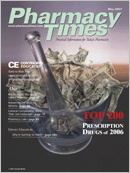Publication
Article
Pharmacy Times
Child-resistant Does Not Mean Childproof
Author(s):
In 2005, media in Minneapolis, Minn,reported a tragic story about a 15-month-old child who died afteringesting the contents of a bottle thatcontained a compounded liquid formulationof flecainide. The child had a congenitalheart defect, which required her parentsto administer 3 doses of the medicationeach day. Because she occasionallyrequired an extra dose to controlacute episodes of tachycardia, her parentscarried the medication in the child'sdiaper bag. At a friend's home, the mothersat the child on the floor next to thediaper bag while she ran into the kitchento get a bottle of milk from the refrigerator.In that short amount of time, her childwas able to remove the cap from thebottle and drink the medication. The childwas rushed to the hospital but could notbe saved.
The parents were shocked at howeasily the 15-month-old child was ableto remove the child-resistant cap andwere surprised that they were neverwarned of the severe risks of this medicationat any time during her treatment.They shared their story with localmedia after viewing a news investigationthat alerted parents to how easily agroup of children between the ages of 3and 8 years old could open the variouschild-resistant containers from a samplingof area pharmacies. Despite thevariation of bottles and vials withaccompanying child-resistant caps, allappeared to meet federal standardsoutlined in the Poison PreventionPackaging Act (PPPA).
The PPPA was established in the early1970s in response to the number ofunintentional poisoning deaths amongyoung children. This act gives the USConsumer Product Safety Commissionthe authority to require child-resistantpackaging on oral prescription medicationsas well as many household products.A child-resistant package isdefined as one that is designed to besignificantly difficult for children under 5years of age to open or obtain a harmfulamount of the contents within a reasonabletime and not difficult for normaladults to use properly. To be child-resistant,85% of tested children less than 5years old must not be able to open thepackage within 5 minutes (this means15% of children can open the packagequickly), and 90% of tested adults mustbe able to open and properly close thepackage within 5 minutes. Although thispackaging has significantly decreasedthe number of unintentional poisoningdeaths among children under 5 yearsold, poison centers across the nationreceived more than 1.3 million calls in2003 about unintentional exposures.Over 40% of these calls were related topharmaceutical ingestions by youngchildren.
Safe Practice Recommendations
Consider the following to help protectchildren from accidental poisonings:
•Remind patients that all prescriptionand OTC medications, as well as vitamins,herbals, and household products,are potentially dangerous to childrenand should be kept out of their reachand sight
•Alert parents, grandparents, and caregiversthat medications stored innon-child-resistant vials, pillboxes, orweekly pill planners must not be accessibleto children. More than one third ofall childhood ingestions involve agrandparent's medication.
•If non-child-resistant caps are requested,explain or provide a leaflet thatexplains the risk of accidental poisoningsand what preventive steps shouldbe taken to safeguard medications.Promote the use of child-resistantcaps, especially for those who havechildren that live with or visit them.
•Demonstrate the proper method toopen and close the child-resistantcontainer to those who find it difficult,before resorting to non-child-resistantcaps
•Periodically query patients with blanketrequests for non-child-resistant closuresto verify that they understand theconsequences if children access thesemedications
•Ensure that child-resistant packagingused at your pharmacy meets currentstandards by requesting child-resistantpackaging test data from the prescriptionvial manufacturer or supplier
•Do not mix vials and closures from differentmanufacturers because theymay not function properly together
•Utilize additional resources that areavailable at:www.poisonprevention.organd www.cpsc.gov.
Dr. Gaunt is a medication safetyanalyst and the editor of ISMPMedication Safety Alert!Community/Ambulatory CareEdition.
Subscribe to Newsletter
Pharmacy Times and the Institute for SafeMedication Practices (ISMP) would like to makecommunity pharmacy practitioners aware of a publicationthat is available.
The ISMP Medication Safety Alert! Community/Ambulatory Care Edition is a monthly compilation ofmedication-related incidents, error-prevention recommendations,news, and editorial content designedto inform and alert community pharmacypractitioners to potentially hazardous situationsthat may affect patient safety. Individual subscriptionprices are $48 per year for 12 monthlyissues. Discounts are available for organizationswith multiple pharmacy sites. This newsletter isdelivered electronically. For more information, contactISMP at 215-947-7797, or send an e-mailmessage to community@ismp.org.







